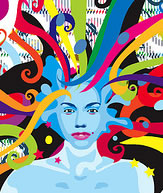In 2005 Malcolm Gladwell published a book called Blink: The Power of Thinking Without Thinking. It had an extremely seductive message: that complex decisions are often more accurate when made quickly, unconsciously, in the blink of an eye.
Gladwell described a man who could spot fake antiquities that had fooled all the experts in an instant and another who took only minutes to accurately assess the longevity of a couple’s relationship. It seemed that the received wisdom about complex decision-making was changing.
The claims Gladwell made for rapid cognition had their roots in a surprising line of evidence emerging in the psychological literature. Some experiments had begun to show the power of unconscious over conscious thought in complex decision-making.
In one experiment Dijksterhuis (2004) asked participants to choose between a series of apartments with different characteristics, but distracted one group to stop them thinking consciously about their decision. Compared with a group allowed to consciously deliberate, participants who had been forced to think unconsciously by the distraction made better decisions.
The backlash
This finding appeared highly counter-intuitive and psychologists were soon hard at work trying to replicate it. The answers are now starting to come in. Three recent studies have re-examined Dijksterhuis’ findings to try and confirm whether or not the effect is real.
In the first a team at the University of New South Wales and the University of Essex, writing in the Quarterly Journal of Experimental Psychology, describe four separate experiments searching for the fabled power of unconscious thought (Newell et al., 2009). One of these was a straight replication of Dijksterhuis’ study and the other three were variations on the theme. All four experiments pointed towards the same conclusion:
“In stark contrast to the claims in the literature and the media we found very little evidence of the superiority of unconscious though for complex decisions.” (Newell et al., 2009; p.19).
Indeed in more naturalistic conditions conscious thought was sometimes superior to unconscious thought.
Two other recent papers published in the journal Judgement and Decision Making also failed to find the purported benefit for unconscious thought. Acker (2008) analysed the results of 17 attempted replications of the unconscious thought effect. These studies showed that it was conscious thought that was most effective in complex decision-making and indeed unconscious thought tended to muddy the waters.
In a second paper recently published in the same journal Thorsteinson and Rakow (2009) again found no evidence for the power of unconscious thought. Indeed their results suggested that the very best way to make decisions was consciously and by resorting to a very old-fashioned but highly effective piece of technology: pencil and paper. Participants who made notes to compensate for the vagaries of memory were likely to make the best decisions.
Power of the unconscious
Despite these null findings, Dijksterhuis’s studies and the points made by Gladwell in his book Blink can’t be discounted. Although unconscious thought may not be superior to conscious thought, it is frequently not that inferior. We still seem to make remarkably good decisions without consciously thinking, which is heartening in itself.
Conscious thought also has its disadvantages — most famously in the literature, thinking too much. Participants in one study when asked to think about the reasons for their decisions went on to make worse choices (Wilson & Schooler, 1991). A further study found that consciously introspecting about a tricky decision tended to interfere with cognitive processing and blur the differences between choices (Tordesillas & Chaiken, 1999).
For all its faults, though, the rather less glamorous approach of conscious deliberation in complex decision-making currently wins the day. These recent experiments suggest the power of unconscious thought is less dazzling than some would have us believe.
Consequently there’s still a lot to be said for ruling a piece of paper down the middle and putting the pros on one side and cons on the other. You’re unlikely to do any worse than making a snap decision and will probably do better. Better to think rather than blink.

